What to Detect and Fix Water Leaks in the Bathroom: Pro Approaches
What to Detect and Fix Water Leaks in the Bathroom: Pro Approaches
Blog Article
The article author is making a few great points about How to Check for Bathroom Leaks overall in the article beneath.

Bathroom leakages are frustrating as they disrupt your day's strategy. It is an alleviation that many restroom leakages are easy to deal with as well as discover, with minimal expense effects.
Having a water leak in restroom can be demanding to the homeowner. The article serves as a "very first help" when you need an emergency situation feedback to a water leakage in washroom.
Detection and Repair Work of Water Leak in Shower Room
Water leakage in washroom typically results from pipes and pipe faults. You might need a standard understanding of these leak types to identify the water leak in bathroom.
Clogged Bathroom Sinks
Sometimes, the water leakage in washroom results from sink blockages. It is very easy to deal with clogs, and also you may not require specialist skills.
What to Do
You can use a drainpipe serpent to remove the particles in the drainpipe as well as allow the stationary water flow. Drain cleansers are also readily available in shops and are easy to utilize.
Bathroom Leaks
Sometimes, water leaks from the toilet and pools around the toilet base. It is an eyesore in the bathroom and requires timely interest.
What to Do
If there are loose screws in between the tank and also bathroom, you only need to tighten them. Sometimes you may need to reapply wax on the gasket or call in a shower room leakage professional to replace broken or used parts.
Dash Leaks
These frequently result from water splashing on the washroom flooring from the bath tub. It damages the bathroom flooring as well as might cause rot to wooden floorings and also shower room doors.
What to Do
This shower room leak is the simplest to take care of. You just need to replace the drapes or recaulk the tub or shower. You may need to alter these to avoid more damage if the leak has actually damaged the bathroom floor or door. The good news is that you can include a plumbing specialist to help with the washroom repair.
Conclusion
Water leaks in the bathroom are preventable occasions in the home. Maintenance and also routine checks aid to keep every little thing in great shape. Yet, you can never be too careful, as well as these events still happen. When they do, fix them immediately, or engage the solutions of an expert.
The post serves as a "very first help" when you need an emergency feedback to a water leak in restroom.
Water leakage in washroom commonly results from pipes as well as pipeline faults. You may need a fundamental understanding of these leakage kinds to discover the water leak in washroom. Sometimes, the water leak in restroom results from sink blockages. It damages the shower room flooring as well as might trigger rot to wood floorings and also washroom doors.
Tricks for Locating a Water Leak in Your Bathroom
Run a Test Using Your Water Meter
One of the clearest indications of a leak in your household is if there’s a sudden unexplained increase in the water bill. For the most part, your water usage shouldn’t change too much from month to month, so a sudden surge is a surefire warning sign.
For further evidence of a leak, Bob Vila recommends this simple test. First, "turn off all the water faucets in your home, and make sure the washing machine and dishwasher are not running." Go to your water meter and look over the reading. After two hours, see if there is a change in the reading. If there is, you've definitely got a leak on your hands and it may be coming from your bathroom!
Test The Toilet
Toilets are among the leading culprits when it comes to unexplained leaks. The rubber stopper (knowns as the flapper) that separates the tank from the bowl can become brittle over time, creating a leak. If you have a toilet that periodically runs on its own for a few seconds, this is probably why.
To confirm your suspicions, put a couple of drops of food coloring into the tank of the toilet. Return after a few minutes and check the bowl. If the dye has entered the bowl, then there’s a leak that should be repaired.
Check for Water Damage to The Walls and Ceilings
If you have a leak emanating from an upstairs bathroom, one of the first things you’ll notice is water damage on the ceiling of the room below. Watermarks and discoloration are clear indicators of leaks, but you might also notice flaking or peeling paint.
Remember: Water doesn't always follow predictable routes. So if you see water marks on the walls, those could also be the result of a leaky upstairs bathroom.
Be Aware of Musty Odors
When it comes to bathroom leaks, the nose often knows best. An undetected leak can go on for quite some time, resulting in the ideal conditions for mold and mildew. Mold has an unpleasant odor and is a sign that your home could be suffering from significant water damage. It’s also a health hazard, especially for those who suffer from respiratory illnesses and allergies, so it's important you have it remedied as quickly as you can.
Inspect Bathtub and Shower Seals
You might not see any leaks or notice any obvious signs of water damage, but it’s important that you look for gaps between the seals surrounding your shower, bathtub, and walls. These kinds of leaks may require extensive renovations if they’re not repaired promptly.
Any presence of moisture on the seals is indicative of a problem, as is peeling or bubbling paint on the bathroom walls. If you have vinyl flooring, be cognizant of curling or bubbles and soft spots in the wood beneath.
https://www.waterdamagerestorationaz.com/locating-bathroom-water-leak-tricks

We were made aware of that editorial on How to Check for Bathroom Leaks through an acquaintance on a different site. Sharing is caring. You won't know, you may just be doing someone a favor. Thanks for your time. Come back soon.
Sink issues? Expert consultation here. Report this page